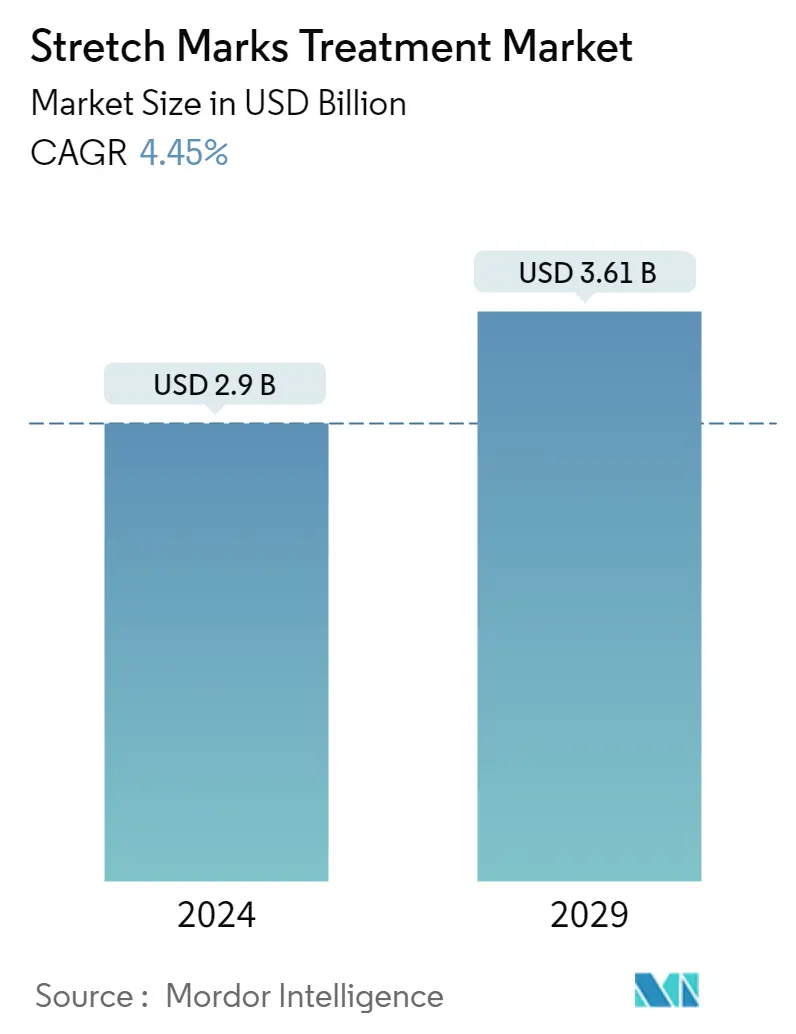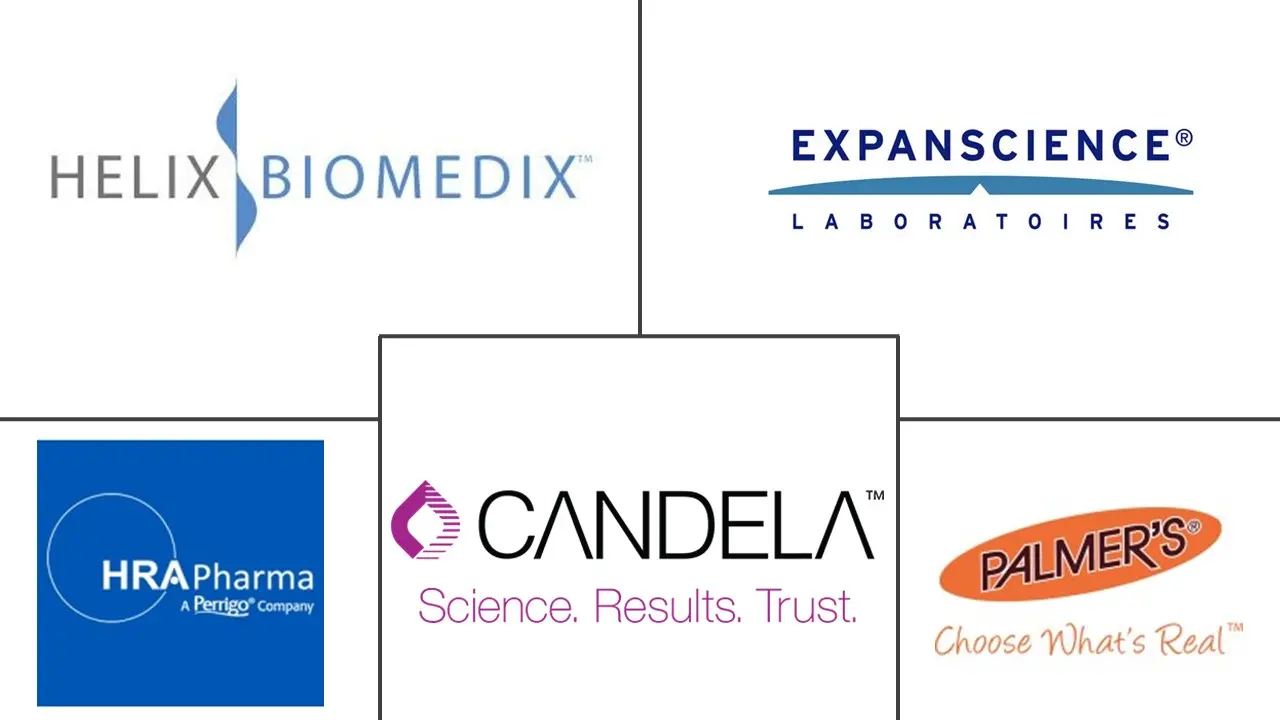Market Size of Stretch Marks Treatment Industry

| Study Period | 2021 - 2029 |
| Market Size (2024) | USD 2.90 Billion |
| Market Size (2029) | USD 3.61 Billion |
| CAGR (2024 - 2029) | 4.45 % |
| Fastest Growing Market | Asia Pacific |
| Largest Market | North America |
Major Players
*Disclaimer: Major Players sorted in no particular order |
Stretch Marks Treatment Market Analysis
The Stretch Marks Treatment Market size is estimated at USD 2.9 billion in 2024, and is expected to reach USD 3.61 billion by 2029, growing at a CAGR of 4.45% during the forecast period (2024-2029).
The COVID-19 pandemic significantly impacted the stretch marks treatment market due to the rising cases of weight gain among people during the pandemic, which is a major cause for the development of stretch marks. For instance, according to an article published in Frontiers in Public Health in January 2022, weight gain was documented in several studies conducted worldwide during the COVID-19 lockdowns. According to the same source, in two studies conducted in the United States, between 22% and 27.5% of people gained weight as a result of the pandemic, which led to increased adoption of stretch marks treatment to get rid of stretch marks gained by obesity. Post the pandemic, the market exhibited significant growth due to the rising hospital admissions for non-elective procedures, such as laser treatment for stretch marks, and rising healthcare spending on aesthetic procedures.
The market's growth is majorly due to the rising burden of obesity across the world and the growing number of pregnancies. For instance, according to the World Obesity Federation 2022, about 1 billion people globally, including 1 in 5 women and 1 in 7 men, are likely to be living with obesity by 2030. This figure indicates a huge burden of obesity in the world, which is likely to augment the market's growth over the forecast period.
A high number of pregnancies are being recorded in developed and developing countries, further augmenting the demand for stretch mark treatment products. For instance, in the United States, there were 3,659,289 births, as per the data published by the CDC in 2021. This trend is expected to increase the adoption of stretch marks removal products after pregnancy.
As per the November 2021 study on people of Saudi Arabia, published by the NIH, the prevalence of stretch marks was higher in females, younger people, smokers, those with a family history of stretch marks, and those with a higher BMI and multiparity. Hence, such factors are likely to generate demand for advanced products to treat stretch marks, further boosting the market's growth.
However, the high costs of laser and microdermabrasion treatment are expected to hinder the market's growth in the future.
Stretch Marks Treatment Industry Segmentation
As per the scope of the report, a stretch mark is a type of scar that develops when the skin stretches or shrinks quickly. The abrupt change causes the collagen and elastin, which support the skin, to rupture. Stretch marks appear as the skin heals. Rapid weight loss or gain and pregnancy are the most common reasons for stretch marks.
The stretch marks treatment market is segmented by treatment (topical products (creams, oils and serum, and lotion), laser (fractional lasers, pulse-dye lasers, and other lasers), and other treatments), end user (hospitals and clinics and home use), and geography (North America, Europe, Asia-Pacific, Middle East and Africa, and South America). The market report also covers the estimated market sizes and trends for 17 countries across major regions globally. The report offers the value (in USD million) for these segments.
| By Treatment | |||||
| |||||
| |||||
| Other Treatments |
| By End User | |
| Hospitals and Clinics | |
| Home Use |
| Geography | ||||||||
| ||||||||
| ||||||||
| ||||||||
| ||||||||
|
Stretch Marks Treatment Market Size Summary
The stretch marks treatment market is poised for steady growth over the forecast period, driven by increasing obesity rates and a rising number of pregnancies globally. The COVID-19 pandemic has notably influenced market dynamics, as weight gain during lockdowns led to a surge in demand for stretch mark treatments. Post-pandemic, the market has seen significant expansion due to increased healthcare spending on aesthetic procedures and non-elective treatments like laser therapy. The prevalence of stretch marks is particularly high among specific demographics, such as women, younger individuals, and those with a family history of the condition, further fueling demand for advanced treatment options. Despite the high costs associated with some treatments, the availability and affordability of products like oils and serums are contributing to market growth, especially in developing regions where cost-effective solutions are preferred.
North America is expected to maintain a significant market share, supported by advanced healthcare infrastructure, technological innovations, and a high prevalence of obesity. The region benefits from better treatment options and a large target population, with studies confirming the efficacy of various treatment methods. The market is moderately competitive, with several local players and new entrants likely to capture market share. Recent product launches, such as Bio-Oil's All-Natural version and Givaudan Active Beauty's Centella CAST, highlight the ongoing innovation in the sector. These developments, along with the introduction of advanced technologies like Icoone Roboderm, are expected to further drive market growth, offering customizable and effective solutions for stretch mark reduction.
Stretch Marks Treatment Market Size - Table of Contents
-
1. MARKET DYNAMICS
-
1.1 Market Overview
-
1.2 Market Drivers
-
1.2.1 Growing Burden of Obesity Worldwide
-
1.2.2 Increasing Number of Pregnancies and Concerns About Stretch Marks
-
-
1.3 Market Restraints
-
1.3.1 High Cost of Laser and Microdermabrasion Treatment
-
-
1.4 Porter's Five Forces Analysis
-
1.4.1 Threat of New Entrants
-
1.4.2 Bargaining Power of Buyers/Consumers
-
1.4.3 Bargaining Power of Suppliers
-
1.4.4 Threat of Substitute Products
-
1.4.5 Intensity of Competitive Rivalry
-
-
-
2. MARKET SEGMENTATION (Market Size by Value - USD million)
-
2.1 By Treatment
-
2.1.1 Topical Products
-
2.1.1.1 Creams
-
2.1.1.2 Oils and Serum
-
2.1.1.3 Lotion
-
-
2.1.2 Laser
-
2.1.2.1 Fractional Lasers
-
2.1.2.2 Pulse-dye Lasers
-
2.1.2.3 Other Lasers
-
-
2.1.3 Other Treatments
-
-
2.2 By End User
-
2.2.1 Hospitals and Clinics
-
2.2.2 Home Use
-
-
2.3 Geography
-
2.3.1 North America
-
2.3.1.1 United States
-
2.3.1.2 Canada
-
2.3.1.3 Mexico
-
-
2.3.2 Europe
-
2.3.2.1 Germany
-
2.3.2.2 United Kingdom
-
2.3.2.3 France
-
2.3.2.4 Italy
-
2.3.2.5 Spain
-
2.3.2.6 Rest of Europe
-
-
2.3.3 Asia-Pacific
-
2.3.3.1 China
-
2.3.3.2 Japan
-
2.3.3.3 India
-
2.3.3.4 Australia
-
2.3.3.5 South Korea
-
2.3.3.6 Rest of Asia-Pacific
-
-
2.3.4 Middle East and Africa
-
2.3.4.1 GCC
-
2.3.4.2 South Africa
-
2.3.4.3 Rest of Middle East and Africa
-
-
2.3.5 South America
-
2.3.5.1 Brazil
-
2.3.5.2 Argentina
-
2.3.5.3 Rest of South America
-
-
-
Stretch Marks Treatment Market Size FAQs
How big is the Stretch Marks Treatment Market?
The Stretch Marks Treatment Market size is expected to reach USD 2.90 billion in 2024 and grow at a CAGR of 4.45% to reach USD 3.61 billion by 2029.
What is the current Stretch Marks Treatment Market size?
In 2024, the Stretch Marks Treatment Market size is expected to reach USD 2.90 billion.

